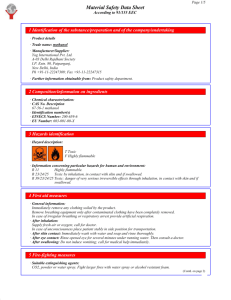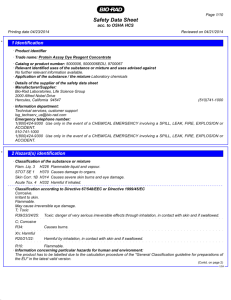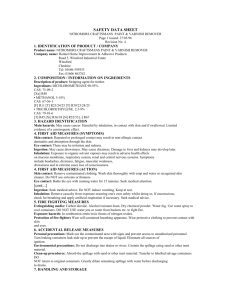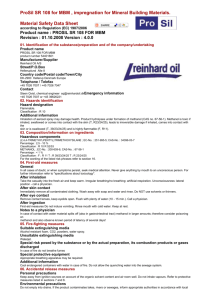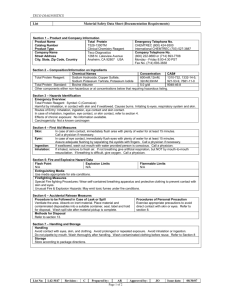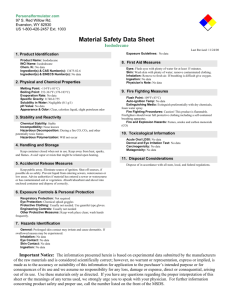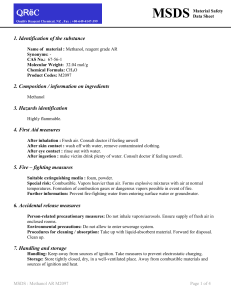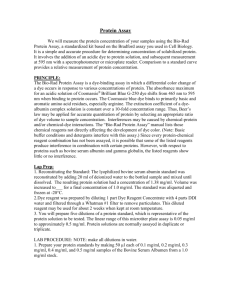Protein Assay Dye Reagent
advertisement
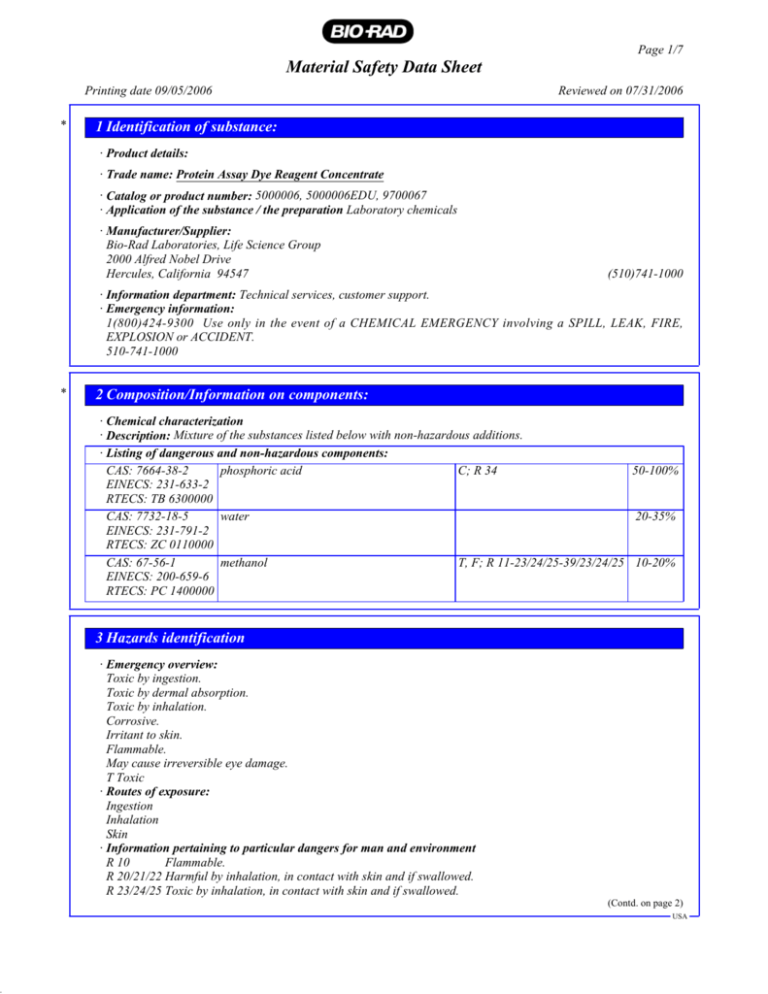
DR Page 1/7 Material Safety Data Sheet Printing date 09/05/2006 * Reviewed on 07/31/2006 1 Identification of substance: · Product details: · Trade name: Protein Assay Dye Reagent Concentrate · Catalog or product number: 5000006, 5000006EDU, 9700067 · Application of the substance / the preparation Laboratory chemicals · Manufacturer/Supplier: Bio-Rad Laboratories, Life Science Group 2000 Alfred Nobel Drive Hercules, California 94547 (510)741-1000 · Information department: Technical services, customer support. · Emergency information: 1(800)424-9300 Use only in the event of a CHEMICAL EMERGENCY involving a SPILL, LEAK, FIRE, EXPLOSION or ACCIDENT. 510-741-1000 * 2 Composition/Information on components: · Chemical characterization · Description: Mixture of the substances listed below with non-hazardous additions. · Listing of dangerous and non-hazardous components: phosphoric acid C; R 34 50-100% CAS: 7664-38-2 EINECS: 231-633-2 RTECS: TB 6300000 water 20-35% CAS: 7732-18-5 EINECS: 231-791-2 RTECS: ZC 0110000 methanol T, F; R 11-23/24/25-39/23/24/25 10-20% CAS: 67-56-1 EINECS: 200-659-6 RTECS: PC 1400000 3 Hazards identification · Emergency overview: Toxic by ingestion. Toxic by dermal absorption. Toxic by inhalation. Corrosive. Irritant to skin. Flammable. May cause irreversible eye damage. T Toxic · Routes of exposure: Ingestion Inhalation Skin · Information pertaining to particular dangers for man and environment R 10 Flammable. R 20/21/22 Harmful by inhalation, in contact with skin and if swallowed. R 23/24/25 Toxic by inhalation, in contact with skin and if swallowed. (Contd. on page 2) USA DR Page 2/7 Material Safety Data Sheet Printing date 09/05/2006 Reviewed on 07/31/2006 Trade name: Protein Assay Dye Reagent Concentrate (Contd. of page 1) R 34 Causes burns. R 39 Danger of very serious irreversible effects. · Classification system The classification was made according to the latest editions of the EU-lists, and expanded upon from company and literature data. · OSHA hazard ratings · Health 2: Moderate hazard. 3: Serious hazard. · Fire 2: Moderate hazard. 4 First aid measures · General information Immediately remove any clothing soiled by the product. Symptoms of poisoning may even occur after several hours; therefore medical observation for at least 48 hours after the accident. Remove breathing apparatus only after contaminated clothing have been completely removed. In case of irregular breathing or respiratory arrest provide artificial respiration. · After inhalation Supply fresh air or oxygen; call for doctor. In case of unconsciousness place patient stably in side position for transportation. Supply fresh air. If required, provide artificial respiration. Keep patient warm. Consult doctor if symptoms persist. · After skin contact Immediately wash with water and soap and rinse thoroughly. · After eye contact Rinse opened eye for several minutes under running water. Then consult a doctor. · After swallowing Do not induce vomiting; immediately call for medical help. Immediately call a doctor. Drink copious amounts of water and provide fresh air. Immediately call a doctor. · Information for doctor · The following symptoms may occur: Breathing difficulty 5 Fire fighting measures · Suitable extinguishing agents CO2, extinguishing powder or water spray. Fight larger fires with water spray or alcohol resistant foam. · Protective equipment: Mount respiratory protective device. Wear self-contained respiratory protective device. 6 Accidental release measures · Person-related safety precautions: Wear protective equipment (See section 8). Keep unprotected persons away. · Measures for environmental protection: Dilute with plenty of water. Do not allow to enter sewers/ surface or ground water. · Measures for cleaning/collecting: Absorb with liquid-binding material (sand, diatomite, acid binders, universal binders, sawdust). Use neutralizing agent. (Contd. on page 3) USA DR Page 3/7 Material Safety Data Sheet Printing date 09/05/2006 Reviewed on 07/31/2006 Trade name: Protein Assay Dye Reagent Concentrate (Contd. of page 2) Dispose contaminated material as waste according to item 13. Ensure adequate ventilation. * 7 Handling and storage · Handling · Information for safe handling: Ensure good ventilation/exhaustion at the workplace. Open and handle receptacle with care. No special precautions are necessary if used correctly. · Information about protection against explosions and fires: Keep ignition sources away - Do not smoke. Protect against electrostatic charges. Keep respiratory protective device available. · Storage · Requirements to be met by storerooms and receptacles: According to product specification · Information about storage in one common storage facility: Not required. · Further information about storage conditions: Keep receptacle tightly sealed. * 8 Exposure controls and personal protection · Additional information about design of technical systems: No further data; see item 7. · Components with limit values that require monitoring at the workplace: 7664-38-2 phosphoric acid PEL () 1 mg/m³ REL () Short-term value: 3 mg/m³ Long-term value: 1 mg/m³ TLV () Short-term value: 3 mg/m³ Long-term value: 1 mg/m³ 67-56-1 methanol PEL () 260 mg/m³, 200 ppm REL () Short-term value: 325 mg/m³, 250 ppm Long-term value: 260 mg/m³, 200 ppm Skin TLV () Short-term value: 328 mg/m³, 250 ppm Long-term value: 262 mg/m³, 200 ppm Skin; BEI · Additional information: The lists that were valid during the creation were used as basis. · Personal protective equipment · General protective and hygienic measures Keep away from foodstuffs, beverages and feed. Immediately remove all soiled and contaminated clothing Wash hands before breaks and at the end of work. Store protective clothing separately. Avoid contact with the eyes and skin. · Breathing equipment: In case of brief exposure or low pollution use respiratory filter device. In case of intensive or longer exposure use respiratory protective device that is independent of circulating air. · Protection of hands: Protective gloves. (Contd. on page 4) USA DR Page 4/7 Material Safety Data Sheet Printing date 09/05/2006 Reviewed on 07/31/2006 Trade name: Protein Assay Dye Reagent Concentrate (Contd. of page 3) · Material of gloves Synthetic gloves · Penetration time of glove material The exact break through time has to be found out by the manufacturer of the protective gloves and has to be observed. · Eye protection: Tightly sealed goggles. * 9 Physical and chemical properties: · General Information Form: Color: Odor: liquid Blue Acrid · Change in condition Melting point/Melting range: undetermined Boiling point/Boiling range: 81°C · Flash point: 21 - 55°C · Ignition temperature: 455.0°C · Auto igniting: Product is not selfigniting. · Danger of explosion: Product is not explosive. However, formation of explosive air/vapor mixtures are possible. · Explosion limits: Lower: Upper: 5.5 Vol % 44.0 Vol % · Vapor pressure at 20°C: 128.0 hPa · Density at 20°C: 1.28 g/cm³ · Solubility in / Miscibility with Fully miscible Water: · pH-value at 20°C: 1.0 · Solvent content: · Organic solvents: · Water: 15.5 % 29.1 % 10 Stability and reactivity · Thermal decomposition / conditions to be avoided: No decomposition if used according to specifications. · Dangerous reactions No dangerous reactions known · Dangerous products of decomposition: No dangerous decomposition products known USA (Contd. on page 5) DR Page 5/7 Material Safety Data Sheet Printing date 09/05/2006 Reviewed on 07/31/2006 Trade name: Protein Assay Dye Reagent Concentrate (Contd. of page 4) 11 Toxicological information · Acute toxicity: · LD/LC50 values for hazardous components per OSHA criteria: 67-56-1 methanol Oral LD50 5628 mg/kg (rat) Dermal LD50 20000 mg/kg (rat) · Primary irritant effect: · on the skin: Caustic effect on skin and mucous membranes. · on the eye: Strong caustic effect. · Sensitization: No sensitizing effects known. · Additional toxicological information: Toxic Harmful Corrosive Swallowing will lead to a strong caustic effect on mouth and throat and to the danger of perforation of esophagus and stomach. The product shows the following dangers according to the calculation method of the General EU Classification Guidelines for Preparations as issued in the latest version: · Target organs: Skin. Respiratory tract. 12 Ecological information: · General notes: Water hazard class 1 (German Regulation) (Self-assessment): slightly hazardous for water. Do not allow undiluted product or large quantities of it to reach ground water, water course or sewage system. Must not reach bodies of water or drainage ditch undiluted or unneutralized. 13 Disposal considerations · Product: · Recommendation Must not be disposed of together with household garbage. Do not allow product to reach sewage system. Hand over to hazardous waste disposers. · Uncleaned packagings: · Recommendation: Disposal must be made according to official regulations. · Recommended cleansing agent: Water, if necessary with cleansing agents. * 14 Transport information · DOT regulations: 3 · Hazard class: UN2924 · Identification number: III · Packing group: · Proper shipping name (technical name): FLAMMABLE LIQUID, CORROSIVE, N.O.S. (METHANOL, PHOSPHORIC ACID SOLUTION) (Contd. on page 6) USA DR Page 6/7 Material Safety Data Sheet Printing date 09/05/2006 Reviewed on 07/31/2006 Trade name: Protein Assay Dye Reagent Concentrate (Contd. of page 5) · Label 3+8 · Land transport ADR/RID (cross-border) 3 Flammable liquids · ADR/RID class: 338 · Danger code (Kemler): 2924 · UN-Number: II · Packing group: 3+8 · Label 2924FLAMMABLE LIQUID, CORROSIVE, N.O.S. (METHANOL, · Description of goods: PHOSPHORIC ACID SOLUTION) · Maritime transport IMDG: · IMDG Class: · UN Number: · Label · Packing group: · EMS Number: · Marine pollutant: · Proper shipping name: · Air transport ICAO-TI and IATA-DGR: · ICAO/IATA Class: · UN/ID Number: · Label · Packing group: · Proper shipping name: * 3 2924 3+8 II F-E,S-D No FLAMMABLE LIQUID, CORROSIVE, N.O.S. (METHANOL, PHOSPHORIC ACID SOLUTION) 3 2924 3+8 III FLAMMABLE LIQUID, CORROSIVE, N.O.S. (METHANOL, PHOSPHORIC ACID SOLUTION) 15 Regulations · SARA (Superfund Amendents and Reauthorization Act of 1986 - USA) · Section 302/304 (40CFR355.30 / 40CFR355.40): None of the ingredients is listed. · Section 313 (40CFR372.65): 67-56-1 methanol · TSCA (Toxic Substances Control Act): All ingredients are listed. · Cancerogenity categories · EPA (Environmental Protection Agency) None of the ingredients is listed. · IARC (International Agency for Research on Cancer) None of the ingredients is listed. · NTP (National Toxicology Program) None of the ingredients is listed. · TLV (Threshold Limit Value established by ACGIH) None of the ingredients is listed. (Contd. on page 7) USA DR Page 7/7 Material Safety Data Sheet Printing date 09/05/2006 Reviewed on 07/31/2006 Trade name: Protein Assay Dye Reagent Concentrate (Contd. of page 6) · MAK (German Maximum Workplace Concentration) None of the ingredients is listed. · NIOSH-Ca (National Institute for Occupational Safety and Health) None of the ingredients is listed. · OSHA-Ca (Occupational Safety & Health Administration) None of the ingredients is listed. · Markings according to EU guidelines: The product has been classified and marked in accordance with EU Directives / Ordinance on Hazardous Materials · Code letter and hazard designation of product: T Toxic · Hazard-determining components of labelling: methanol phosphoric acid · Risk phrases: 10 Flammable. 20/21/22 Harmful by inhalation, in contact with skin and if swallowed. 23/24/25 Toxic by inhalation, in contact with skin and if swallowed. 34 Causes burns. 39 Danger of very serious irreversible effects. · Safety phrases: 26 In case of contact with eyes, rinse immediately with plenty of water and seek medical advice. 36/37/39 Wear suitable protective clothing, gloves and eye/face protection. 45 In case of accident or if you feel unwell, seek medical advice immediately. 60 This material and its container must be disposed of as hazardous waste. · National regulations Class Share in % III 10-20 · Water hazard class: Water hazard class 1 (Self-assessment): slightly hazardous for water. 16 Other information: This information is based on our present knowledge. However, this shall not constitute a guarantee for any specific product features and shall not establish a legally valid contractual relationship. · Department issuing MSDS: Environmental Health and Safety. · Contact: Life Science Group, Environmental Health and Safety, 2000 Alfred Nobel Drive, Hercules, California, 94547: 1(510) 741-1000 Diagnostic Group, Environmental Health and Safety, 4000 Alfred Nobel Drive, Hercules, California, 94547: 1(510) 724-7000 · * Data compared to the previous version altered. USA
